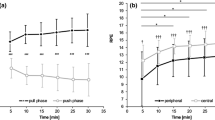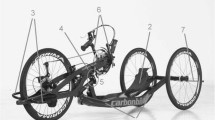Abstract
In Paralympic sports, biomechanical optimisation of movements and equipment seems to be promising for improving performance. In handcycling, information about the biomechanics of this sport is mainly provided by case studies. The aim of the current study was (1) to examine changes in handcycling propulsion kinematics and kinetics due to increasing workloads and (2) identify parameters that are associated with peak aerobic performance. Twelve non-disabled male competitive triathletes without handcycling experience voluntarily participated in the study. They performed an initial familiarisation protocol and incremental step test until exhaustion in a recumbent racing handcycle that was attached to an ergometer. During the incremental test, tangential crank kinetics, 3D joint kinematics, blood lactate and ratings of perceived exertion (local and global) were identified. As a performance criterion, the maximal power output during the step test (Pmax) was calculated and correlated with biomechanical parameters. For higher workloads, an increase in crank torque was observed that was even more pronounced in the pull phase than in the push phase. Furthermore, participants showed an increase in shoulder internal rotation and abduction and a decrease in elbow flexion and retroversion. These changes were negatively correlated with performance. At high workloads, it seems that power output is more limited by the transition from pull to push phase than at low workloads. It is suggested that successful athletes demonstrate small alterations of their kinematic profile due to increasing workloads. Future studies should replicate and expand the test spectrum (sprint and continuous loads) as well as use methods like surface electromyography (sEMG) with elite handcyclists.





Similar content being viewed by others
Change history
29 May 2018
In the original article, the surname of the second author is published incorrectly. The correct author name should be “Joshua Meskemper”.
Abbreviations
- AL:
-
Arm length
- ANOVA:
-
Analysis of variance
- AOC:
-
Height of the acromion above crank axis
- b T :
-
Increase in power output with each step of the incremental test
- BR:
-
Back rest
- Cad:
-
Cadence
- EF:
-
Elbow flexion
- HRmax :
-
Maximal heart rate during the incremental test
- Lamax :
-
Maximal lactate concentration during the incremental test
- M :
-
Torque
- MaxI:
-
Crank angle of maximal value
- Max or MaxV:
-
Maximal value
- MaxV–MinV:
-
Range
- MinI:
-
Crank angle of minimal value
- Min or MinV:
-
Minimal value
- MV:
-
Mean value
- P 4 :
-
Calculated power output at a fixed lactate concentration of 4 mmol l-1
- PF:
-
Palmar flexion
- P L :
-
Power output of the last step of the incremental test
- P max :
-
Maximal power output during the incremental test
- RPE:
-
Rating of perceived exertion
- SA:
-
Shoulder abduction
- SCI:
-
Spinal cord injury
- SD:
-
Standard deviation
- sEMG:
-
Surface electromyography
- SF:
-
Shoulder flexion
- SR:
-
Shoulder internal rotation
- SW:
-
Shoulder width
- TF:
-
Trunk flexion
- t L :
-
Duration within the last (unfinished) step of the incremental test
- t T :
-
Prescribed duration of each step of the incremental test
- W crank :
-
Rotational work
- @MaxP:
-
Crank angle of maximal power
- @MinP:
-
Crank angle of minimal power
- θ :
-
Angle
- ω :
-
Angular velocity
References
Keogh JWL (2011) Paralympic sport: an emerging area for research and consultancy in sports biomechanics. Sports Biomech 10(3):234–253. https://doi.org/10.1080/14763141.2011.592341
Morrien F, Taylor MJD, Hettinga FJ (2016) Biomechanics in paralympics: implications for performance. Int J Sports Physiol Perform. https://doi.org/10.1123/ijspp.2016-0199
Janssen TW, Dallmeijer AJ, van der Woude LH (2001) Physical capacity and race performance of handcycle users. J Rehabil Res Dev 38(1):33–40
Abel T, Schneider S, Platen P et al (2006) Performance diagnostics in handbiking during competition. Spinal Cord 44(4):211–216. https://doi.org/10.1038/sj.sc.3101845
Abel T, Burkett B, Schneider S et al (2010) The exercise profile of an ultra-long handcycling race: the Styrkeproven experience. Spinal Cord 48(12):894–898. https://doi.org/10.1038/sc.2010.40
Krämer C, Schneider G, Bohm H et al (2009) Effect of different handgrip angles on work distribution during hand cycling at submaximal power levels. Ergonomics 52(10):1276–1286. https://doi.org/10.1080/00140130902971916
Faupin A, Gorce P, Campillo P et al (2006) Kinematic analysis of handbike propulsion in various gear ratios: implications for joint pain. Clin Biomech (Bristol, Avon) 21(6):560–566. https://doi.org/10.1016/j.clinbiomech.2006.01.001
Faupin A, Gorce P, Watelain E et al (2010) A biomechanical analysis of handcycling: a case study. J Appl Biomech 26(2):240–245
Litzenberger S, Mally F, Sabo A (2015) Influence of different seating and crank positions on muscular activity in elite handcycling—a case study. Procedia Eng 112:355–360. https://doi.org/10.1016/j.proeng.2015.07.262
Litzenberger S, Mally F, Sabo A (2016) Biomechanics of elite recumbent handcycling: a case study. Sports Eng 19(3):201–211. https://doi.org/10.1007/s12283-016-0206-x
Reiser M, Meyer T, Kindermann W et al (2000) Transferability of workload measurements between three different types of ergometer. Eur J Appl Physiol 82(3):245–249. https://doi.org/10.1007/s004210050678
Zeller S, Abel T, Smith PM et al (2015) Influence of noncircular chainring on male physiological parameters in hand cycling. J Rehabil Res Dev 52(2):211–220. https://doi.org/10.1682/jrrd.2014.03.0070
Borg GA (1982) Psychophysical bases of perceived exertion. Med Sci Sports Exerc 14(5):377–381
Smith PM, Price MJ, Doherty M (2001) The influence of crank rate on peak oxygen consumption during arm crank ergometry. J Sports Sci 19(12):955–960. https://doi.org/10.1080/026404101317108453
Heck H, Mader A, Hess G et al (1985) Justification of the 4-mmol/l lactate threshold. Int J Sports Med 6(3):117–130. https://doi.org/10.1055/s-2008-1025824
Gardner AS, Stephans S, Martin DT et al (2004) Accuracy of SRM and power tap power monitoring systems for bicycling. Med Sci Sports Exerc 36(7):1252–1258. https://doi.org/10.1249/01.mss.0000132380.21785.03
Vicon Motion Systems (2007) Upper limb model guide. https://www.vicon.com/downloads/documentation/vicon-documentation/upper-limb-model-guide. Accessed 26 Aug 2016
Wu G, van der Helm FCT, Veeger HEJD et al (2005) ISB recommendation on definitions of joint coordinate systems of various joints for the reporting of human joint motion—part II: shoulder, elbow, wrist and hand. J Biomech 38(5):981–992
Field A (2013) Discovering statistics using IBM SPSS statistics: and sex and drugs and rock ‘n’ roll. MobileStudy, 4th edn. Sage, London
Cohen J (1988) Statistical power analysis for the behavioral sciences, 2nd edn. Taylor and Francis, Hoboken
Brand RA, Huiskes R (2001) Structural outline of an archival paper for the Journal of Biomechanics. J Biomech 34(11):1371–1374. https://doi.org/10.1016/s0021-9290(01)00104-x
Bertucci W, Grappe F, Girard A et al (2005) Effects on the crank torque profile when changing pedalling cadence in level ground and uphill road cycling. J Biomech 38(5):1003–1010. https://doi.org/10.1016/j.jbiomech.2004.05.037
Faupin A, Gorce P, Meyer C et al (2008) Effects of backrest positioning and gear ratio on nondisabled subjects’ handcycling sprinting performance and kinematics. JRRD 45(1):109–116. https://doi.org/10.1682/jrrd.2006.10.0139
van Drongelen S, van den Berg J, Arnet U et al (2011) Development and validity of an instrumented handbike: initial results of propulsion kinetics. Med Eng Phys 33(9):1167–1173. https://doi.org/10.1016/j.medengphy.2011.04.018
Madsen N, McLaughlin T (1984) Kinematic factors influencing performance and injury risk in the bench press exercise. Med Sci Sports Exerc 16(4):376–381
Trebs AA, Brandenburg JP, Pitney WA (2010) An electromyography analysis of three muscles surrounding the shoulder joint during the performance of a chest press exercise at several angles. J Strength Cond Res 24(7):1925–1930. https://doi.org/10.1519/jsc.0b013e3181ddfae7
Price MJ, Collins L, Smith PM et al (2007) The effects of cadence and power output upon physiological and biomechanical responses to incremental arm-crank ergometry. Appl Physiol Nutr Metab 32(4):686–692. https://doi.org/10.1139/h07-052
Acknowledgements
The authors would like to thank all participants for their patience and commitment during the study. In addition, they would also to express their gratitude to Alessandro Fasse for his help in data processing and Carolin Stangier for her support during the tests.
Funding
Self-funding.
Author information
Authors and Affiliations
Corresponding author
Ethics declarations
Conflict of interest
We certify that there is no actual or potential conflict of interest in relation to this article.
Additional information
The original version of this article was revised with the correct author name.
Rights and permissions
About this article
Cite this article
Quittmann, O.J., Meskemper, J., Abel, T. et al. Kinematics and kinetics of handcycling propulsion at increasing workloads in able-bodied subjects. Sports Eng 21, 283–294 (2018). https://doi.org/10.1007/s12283-018-0269-y
Published:
Issue Date:
DOI: https://doi.org/10.1007/s12283-018-0269-y




